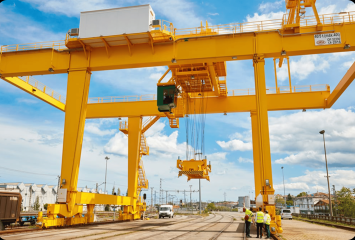
Overhead Crane Operations (Gantry Crane)
Overhead Crane Operations (Gantry Crane) Training Course

Overhead Crane Operations (Gantry Crane) Training Course
This training course is designed to provide individuals with the essential knowledge and practical skills needed to safely and efficiently operate overhead cranes, specifically gantry cranes, in various industrial settings. Gantry cranes are widely used in construction, manufacturing, shipping, and maintenance sectors, where heavy lifting and precise movements are required. The course emphasizes safe operation techniques, load handling, and the use of controls, all within the framework of industry best practices and safety regulations.
Understand Gantry Crane Components: Identify the different parts of the gantry crane, including hoists, trolleys, rails, and controls.
Ensure Safety Compliance: Recognize the importance of safety regulations and standards (e.g., OSHA, ANSI, and other relevant guidelines) in crane operations.
Perform Pre-Operation Inspections: Conduct proper crane inspections before operation to identify any potential hazards.
Operate the Gantry Crane: Gain hands-on experience in safely operating a gantry crane, controlling the lift, lowering, and moving loads with precision.
Load Handling and Rigging: Understand proper rigging techniques and load balancing to ensure safe and efficient lifting.
Emergency Procedures: Learn the necessary actions to take in case of malfunction or emergency situations, including safe shutdown and emergency communication protocols.
Troubleshoot and Maintain: Recognize basic maintenance procedures and troubleshooting techniques to ensure the crane remains in safe working condition.
Evaluate Risks and Hazards: Assess potential risks during crane operations and develop strategies to minimize accidents or injuries.
Introduction to Gantry Cranes
What is a Gantry Crane?
Types of Gantry Cranes (Single Girder vs. Double Girder, etc.)
Overview of Key Components (hoists, trolleys, end trucks, rails, controls, etc.)
Applications and Industry Uses
Safety Regulations and Standards
Overview of OSHA, ANSI, and ISO standards
Importance of safety protocols in crane operations
Personal Protective Equipment (PPE) requirements
Roles and responsibilities of the crane operator
Pre-Operation Checks and Inspections
Routine inspection procedures (visual and functional checks)
Identifying defects and reporting hazards
Ensuring load capacity and environmental considerations
Documentation and maintenance logs
Operating the Gantry Crane
Understanding the control system (joystick, pendant, wireless, etc.)
Hoisting, lowering, and moving loads safely
Proper load control and maneuvering techniques
Managing travel speeds and distance
Operating in different conditions (outdoor, indoor, confined spaces)
Load Handling and Rigging Techniques
Understanding load weights and balancing
Types of slings and rigging equipment
Proper load slinging, positioning, and attachment methods
Avoiding load swinging and controlling momentum
Safety considerations during load transfer
Emergency Procedures and Troubleshooting
Identifying potential hazards and unsafe conditions
Emergency stop functions and actions
Dealing with malfunctions and operator errors
Basic troubleshooting for common crane issues
Safe shutdown and lockout/tagout procedures
Maintenance and Care of Gantry Cranes
Preventative maintenance routines and schedules
Routine lubrication and parts checks
Handling wear and tear on crane components
Reporting and documenting maintenance activities
Safety considerations during maintenance work
Post-Operation Procedures
Proper shutdown procedures
Securing the crane and reporting issues
Post-operation safety checks
Crane Operators
Maintenance Technicians
Safety Officers
Warehouse Managers and Supervisors
Rigging Personnel
Engineers